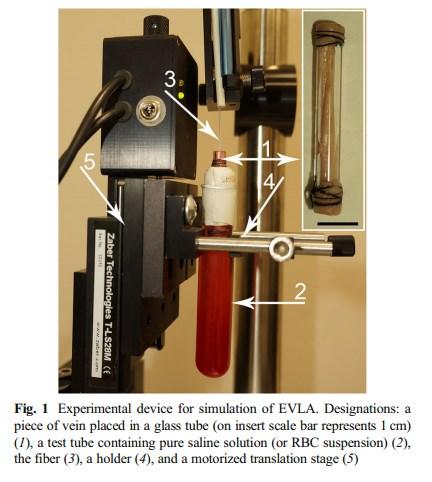New investigation of endovenous laser ablation of varicose veins

Experimental device for simulation of endovenous laser ablation. Credit: from the article
However, this kind of therapy is associated with significant collateral damage because of the high output power of the laser. Therefore, it is an important question in vein surgery to optimize the laser characteristics for ablation.
To realize a process of endovenous laser ablation (EVLA), it is necessary to expose the laser radiation upon a region of the vessel so that it receives sufficient energy to cause thermal damage.
On one hand, the value of this energy should provide coagulation of vein, and on the other, it should be optimized so that the structure of the surrounding healthy tissues has received a minimum degree of damage.
This original study conducted by researchers from Ogarev Mordovia State University and Kazan Federal University presents the results of experiments on endovenous laser ablation of varicose veins in vitro using laser radiation of a solid-state laser and identifying the role a carbonized layer of blood in these experiments.
An experimental series with saline solution and red blood cell (RBC) suspension in the venous lumen was performed to identify the impact of a heated carbonized layer precipitated on the fiber end face versus the efficiency of EVLA. Results of these experiments confirmed that the presence of a heated carbonized layer on the fiber end face increases the efficiency of EVLA.
Further experiments are planned for process optimization. For instance, it is planned to use radial emitting fibers since this technique can minimize a possibility of vein perforations. Also, modification of the experimental device without placement of vein into a glass tube will allow to approach experimental conditions to real.
###
Contract grant sponsors the Ministry of Education and Science of the Russian Federation (the project part of the State Assignment in the sphere of scientific activities no 3.384.2014/? and State Assignment no. 0708 0210059 611); the subsidy of the Russian Government (agreement no. 02.A03.21.0002) to support the Program of Competitive Growth of Kazan Federal University among World's Leading Academic Centers.
Media Contact
All latest news from the category: Medical Engineering
The development of medical equipment, products and technical procedures is characterized by high research and development costs in a variety of fields related to the study of human medicine.
innovations-report provides informative and stimulating reports and articles on topics ranging from imaging processes, cell and tissue techniques, optical techniques, implants, orthopedic aids, clinical and medical office equipment, dialysis systems and x-ray/radiation monitoring devices to endoscopy, ultrasound, surgical techniques, and dental materials.
Newest articles

Solving the riddle of the sphingolipids in coronary artery disease
Weill Cornell Medicine investigators have uncovered a way to unleash in blood vessels the protective effects of a type of fat-related molecule known as a sphingolipid, suggesting a promising new…

Rocks with the oldest evidence yet of Earth’s magnetic field
The 3.7 billion-year-old rocks may extend the magnetic field’s age by 200 million years. Geologists at MIT and Oxford University have uncovered ancient rocks in Greenland that bear the oldest…

Decisive breakthrough for battery production
Storing and utilising energy with innovative sulphur-based cathodes. HU research team develops foundations for sustainable battery technology Electric vehicles and portable electronic devices such as laptops and mobile phones are…





















